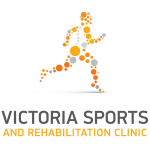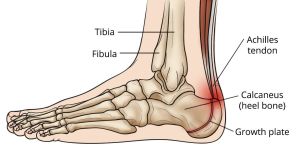With the soccer season well upon us and pre-season a distant memory, activity loads for some children are at their highest, especially if your child is combining other sports and school yard activities. Different sports have a higher prevalence of some conditions but with soccer one of the most common is Sever’s Disease. It is the most common cause of heel pain in active children. It specifically occurs where the achilles tendon attaches to the calcaneal (heel bone). As children are not skeletally mature the bone at the site of the achilles attachment is still growing, therefore excessive cumulative forces can irritate this actively growing bone.
It can affect both boys and girls but at different ages, as boys and girls skeletally mature at different ages. For girls, it is generally between the ages of 8 to 13 and boys 10 to 15 years. Though the peak incidence of Sever’s is 8 to 10 years for girls and 10 to 12 years for boys.
The child may initially complain of pain around the heel. You may also notice that they limp while running. Raising on toes can hurt and squeezing the heel bone between your thumb and pointer finger can cause pain. It may not always be the total sporting load the child is undertaking but also changes in footwear can make a difference. Many children will wear runners over the pre-season which are comfortable, cushioned sports shoes, then make the transition into football boots that can lead to symptoms presenting. Also changes in surfaces, soft grounds to hard grounds can affect symptoms.
Once a diagnosis is made treatment can commence. Not all children with Sever’s disease need to stop playing the sport that they love. One of the first things to do is to address their training load. Many children will be doing many activities beyond their beloved game of soccer on the weekend. Some of the examples children report:
- Soccer Game X 1 (Sometimes 2 games a week)
- Training X 2
- Basketball Game X 1
- Basketball Training X 1
- Recess Football X 5
- Lunch Time Football X 5
All of this combined can equate to a significant load on a growing heel bone. Generally we work with the child to identify the importance of each of these activities, with the least important activities either being modified or removed. Treatment consists of releasing calf musculature, improving foot and ankle mobility and calf strengthening. Sometimes heel cushions, heel raises or foot orthotics can be used.
If Sever’s Disease is poorly managed or left untreated it can lead to permanent bone deformity of the heel bone at the insertion of the achilles tendon. This can lead to issues fitting shoes and causing blisters. The foot biomechanics can be altered, causing issues such as plantar fasciitis, heel spurs or achilles tendonitis/tendonosis caused by tight calf musculature.
If you have any questions regarding Sever’s disease or any other sporting injury your child is experiencing feel free to contact the clinic.
This article is for information only, for a diagnosis and treatment of a musculoskeletal condition consult your Osteopath or primary healthcare professional.

